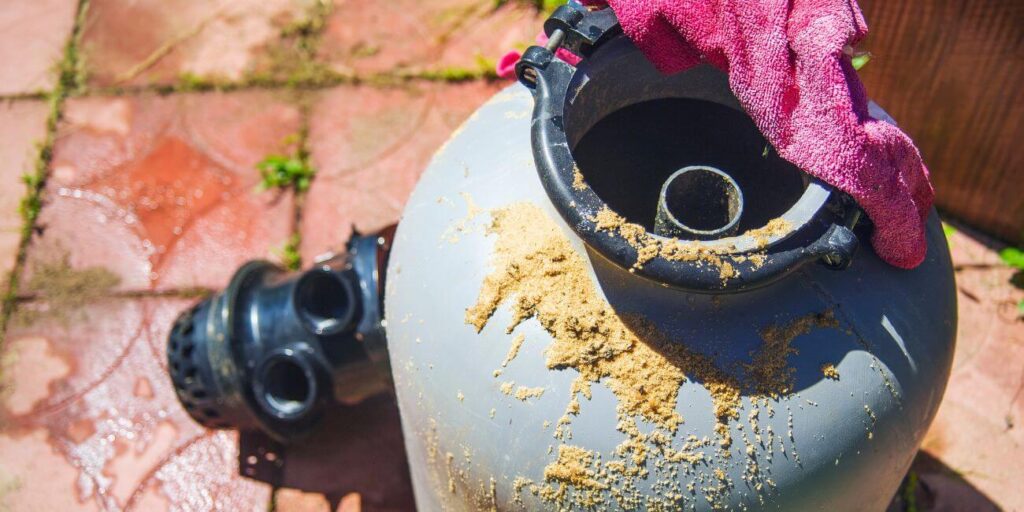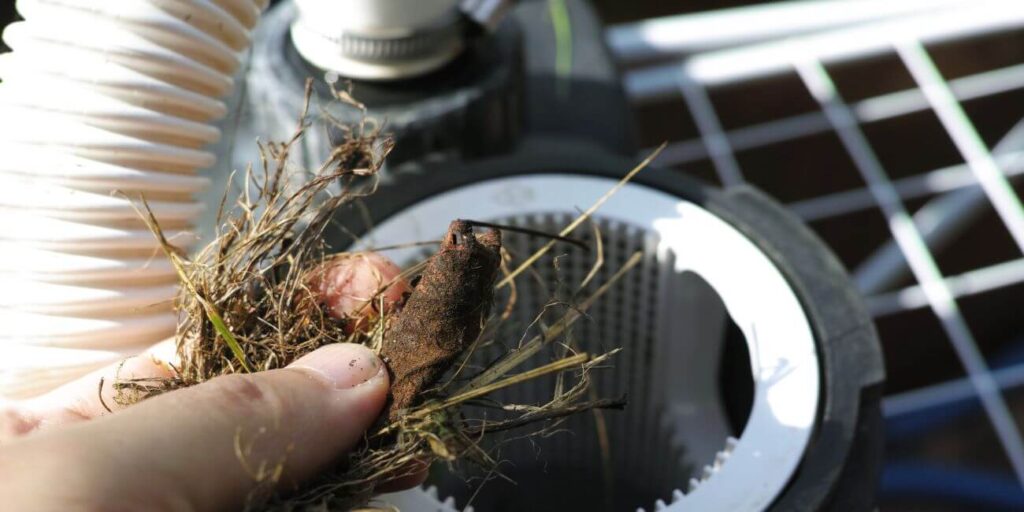How Often Should I Backwash My Pool Sand FilterKeeping a clean swimming pool can bring you a joyful time when you stay in the water while extending the lifespan of facilities of your pool. Therefore, knowing how to backwash your pool sand filter plays the most important part in the maintenance of your swimming pools. In this way, all the buildups can be effectively removed from a pool sand filter, which can make the system work normally and keep the water clear.
Table of Contents
-
-
-
-
- 1. What is the Meaning of Backwashing?
- 2. Factors to Determine the Frequency of Your Backwashing Your Pool Filter
- 3. How to Monitor Your Pool Filter’s Pressure
- 4. When to Backwash?
- 5. How Often Do You Backwash?
- 6. Seasonal Considerations: How Weather Affects Backwashing Frequency
- 7. The Workflow of Backwashing Your Pool Filters
- 8. How Much Time It Takes to Backwash and How to Properly Manage the Process?
- 9. Equipment and Materials Needed to Properly Backwash Your Swimming Pool Filter
- 10. When to Replace Your Pool Sand?
- 11. Conclusion
-
-
-
In this post, we focus on the explanation of all backwashing details, including its importance and proper handling frequency. You can also learn the right time that your pool sand filter need backwashing, necessary tools and when to change the sand in your pool sand filter.
1. What is the Meaning of Backwashing?
Backwashing involves in cleaning a sand filter by running the water through the pool sand filter in a reversing direction. With this method, the debris, dirty things as well as other contaminants that can not be recirculated into the pool water, will be captured and processed in great efficiency. As the time passes, more and more particles will buildup to increase the resistance power to the water flow while the pressure also increases in the whole system.

Why is backwashing so important?
- Clogs Water Flow: The accumulation of dirt on the filter chokes it or hinders water flow, which eventually stops the system from filtering the water in the pool as required.
- Sustains Filter Performance: Periodic back-washing cleaning extricates the garbage entrapped within filters to serve better.
- Saves Wear and Tear: This is because you are not cleaning the filter at intervals; the pump is then put to undue load which eventually damages it.
In a word, backwashing will undoubtedly clean the pool water and make your pool sand filter work with good efficiency.
2. Factors to Determine the Frequency of Your Backwashing Your Pool Filter
This depends on several factors. Though there is no rule, these key factors will let you know the right time to clean your pool filter:
a. Pool Usage and Bather Load
The more the pool is used, the quicker it will clog your filter. Pool parties, swimming lessons, or even general use from a family can introduce oils, lotions, and general debris into the water. A heavier bather load means how often backwashing will need to occur.
b. Environmental Conditions
The environment that your pool is in will have a great effect on how often your pool sand filter will get dirty:
- Wind: Strong winds blow leaves, dirt, and other debris into the pool quickly, perhaps requiring frequent backwashing.
- Rain: Rainstorms wash dirt and organic matter into your pool-especially in areas with heavy runoff-so increasing the load of debris in your filter.
- Pollen: Small particles may accumulate in the filtration media, clogging the sand a lot faster during pollen season, hence needing more frequent backwashing.
c. Filter Media Type
Different filter media respond differently to the matter loads:
The most usual sort of filter in pool programs may be the Sand Filters. Most filters should be washed in reverse when their differential stress reaches 6-8 PSI.
Zeolite and Glass filters – exemplary filters that eliminate finer particles than usual sand filters need washing in reverse more regularly, though.
d. Pool Debris
A pool surrounded by trees, grass, or any other debris-rich environment has more material in the water, which will clog the filter faster. You can tell if leaves or dirt gather in the pool so that you will backwash more often.

3. How to Monitor Your Pool Filter’s Pressure
The best way to estimate when the backwashing might be needed is by checking your filter pressure. Your pool sand filter will have a particular kind of pressure gauge showing resistance inside the filter. After a newly cleaned backwash, pressure will be low and rise as particulate material deposits on the filter. Key points:
- Clean Filter Pressure: A PSI reading should be taken after a backwash as an accurate clean filter pressure reading which will be your basis.
- Pressure Increase: As a rule of thumb, when the clean filter pressure rises 6 to 8 PSI, backwashing should be done.
- Poor Circulation Indicators: If the water appears cloudy, circulation should be properly done or chemicals should be scattered properly.
4. When to Backwash?
Along with pressure readings here are some other visual and working points to give you an idea of whether or not your filter might be needing a cleaning:
- Pressure Increase: In a scenario where the pressure is above the clean reading about 6 to 8 PSI it is definitely the right time for the process of backwashing.
- Cloudy Water: A loss in the efficiency of filtration would also be a factor that can contribute to cloudy pool water. Always pay attention to your filter’s pressure and take into consideration backwashing when water quality worsens.
- Poor Circulation of Water: When water circulation is lower than normal, or the circulation of water around your pool is not occurring, this can also indicate blockages within the filter, requiring cleaning.
- Dirty Pool Surface: In cases where the pool surface becomes dirty and the debris does not seem to filter out with the filter, then it is time for a backwash.
5. How Often Do You Backwash?
Backwash your pool filter when the pressure gauge has increased 6-8 PSI from the normal clean filter pressure. The frequency of such incidence will depend on your usage, environment, and type of filter medium.
This is an approximation, which may vary according to several conditions:
- Normal Pool Conditions: Every 4-6 weeks
- Heavy Pool Usage: Every 2-3 weeks
- During Pollen Season or After Storms: When the pressure gauge increases by 6-8 PSI or when you notice cloudiness in the water.
This schedule may change, and you will need to continuously monitor the pressure of your filter and the appearance of your pool water.
6. Seasonal Considerations: How Weather Affects Backwashing Frequency
As noted above, weather will greatly affect how often you backwash your pool sand filter:
- Winter: If you use your pool during winter, you may have less need for backwashing. However, if the winter is full of storms, you may have to clean it by backwashing just the same.
- Spring-Pollen Season: The filter load of fine particles will be higher and thus may need to be back-washed more frequently.
- Summer: You are probably going to want to backwash more frequently because of the warmer temperatures, storms that would stir up the water and cloud it, and increased use.
- Autumn( or Fall): If your pool is covered or surrounded by a group of trees, perhaps you need to handle the backwashing to removing the leaves.
7. The Workflow of Backwashing Your Pool Filters
Backwashing is not quite a difficult task for you after you the following tips. Here is how you would properly backwash:
- Turn off the Pump: The pool pumps always have to be turned off before working for the sake of safety from wear and tear.
- Move Multiport Valve: If any multiport valve is detected then move from “FILTER” to “BACKWASH.”
- Setup of Backwash Hose: Hook backwash hose properly and channel away from the pool area.
- Turn the Pump On: Once back on, run the pump 2-3 minutes or until water from backwash hose is clear. After the backwashing is complete, position the valve into “RINSE” and let the pump run 1-2 minutes. This will wash the remaining chaulky build up from inside of the filter and pipes.
- Back to Filter Mode: The valve shall be returned to the “FILTER” position, and normal filtration shall resume.
And that is it! Also, to make sure everything goes right, do not forget to check filter pressure after backwashing.
8. How Much Time It Takes to Backwash and How to Properly Manage the Process?
Generally, this usually takes around 5-7 minutes for the backwashing of:
- Backwashing: 2-3 minutes
- Rinsing: 1-2 minutes
- Routine Operation: Proceed with filtering for adequate water circulation.
This will keep your pool in good shape at all times.
9. Equipment and Materials Needed to Properly Backwash Your Swimming Pool Filter
Some of the tools which can help make the process of backwashing easy and smooth are as follows:
- Pressure Gauge: Helps indicate when backwashing should be performed.
- Backwash Hose: A long hose redirecting wastewater away from your swimming pool area.
- Replacement Filter Media: All filters, except cartridge filters, require that their sand be replaced every few years.
- O-Ring Lubricants: Smear the O-rings of your filter valve for leak-free and smooth operation.
10. When to Replace Your Pool Sand?
The sand in your filter will wear out even with regular backwashing and will not catch the fine particles. Replacing the sand will need to be done in 5-7 years or sooner when you see water remaining cloudy for extended periods beyond a backwash, the pressure of water never going down following the backwash, and debris unable to be filtered by the sand anymore.
11. Conclusion
Back-washing during pool maintenance will keep your pool sand filter economically performing well and slash clean/clear water. Note that for the best performance of your pool, one should always observe filter pressure, monitor signs of reduced water circulation, and understand environmental influences on frequency. This, coupled with seasonal, will go a long way in maintaining your filtration system and prolonging the life of your pool equipment. Always backwash when needed, and your pool will be shining like an oasis for years to come!
